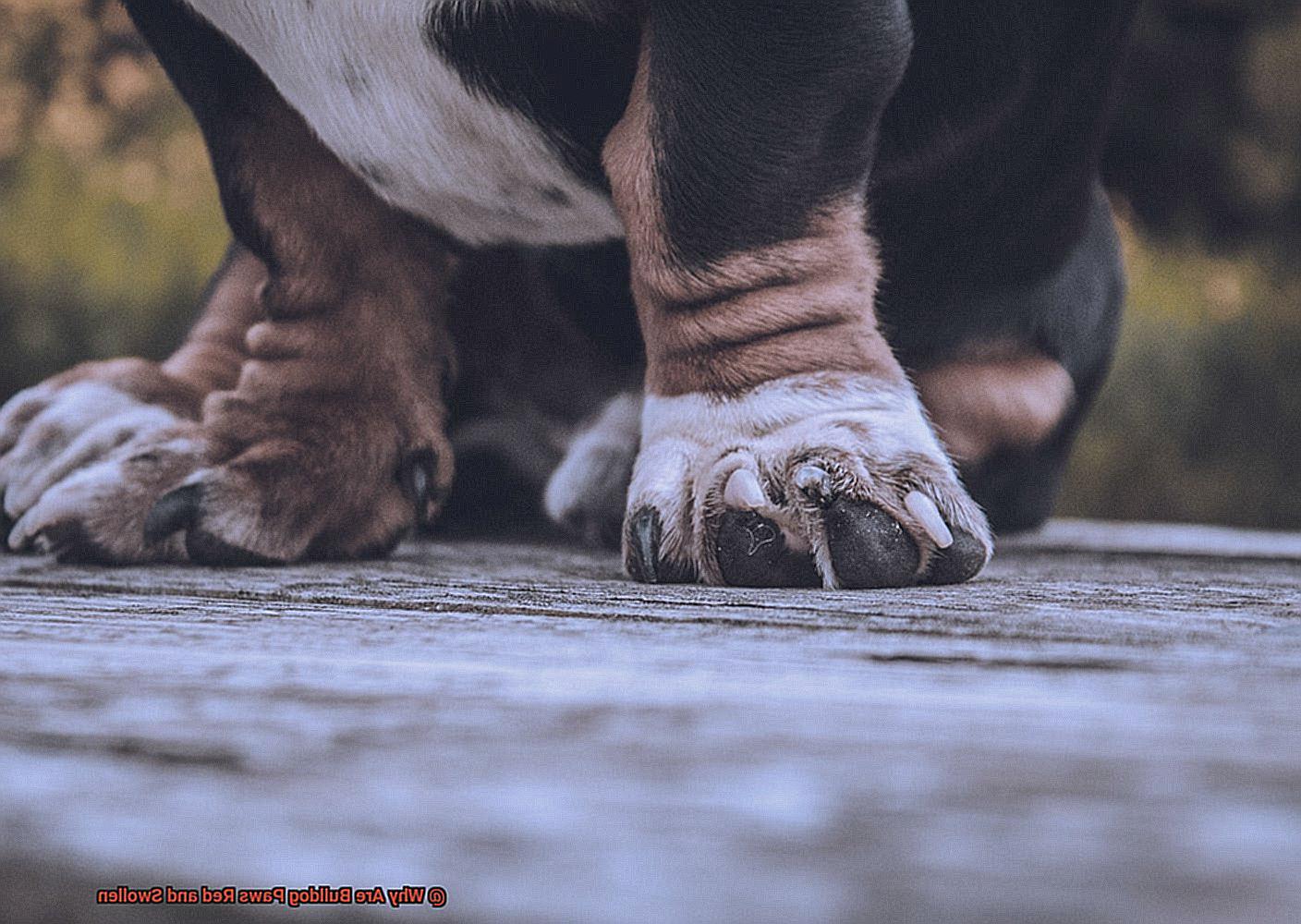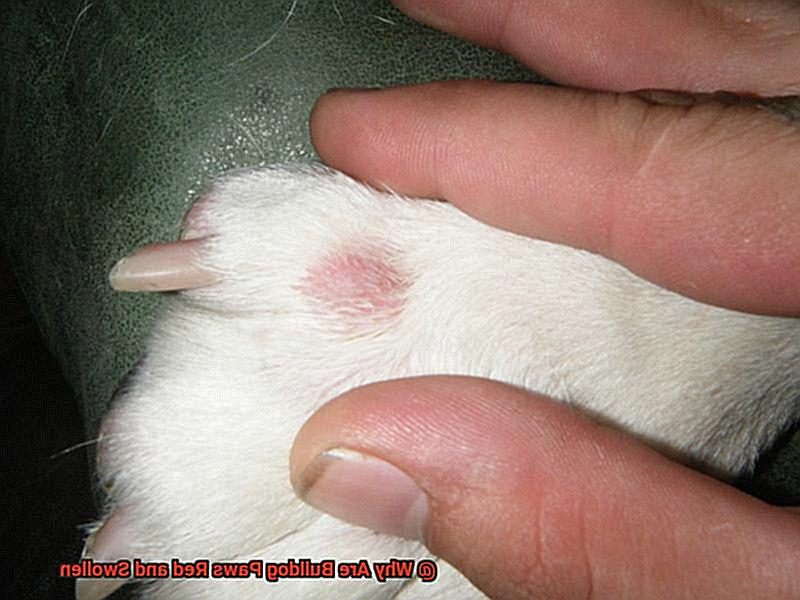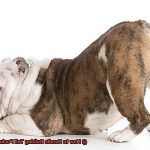Why Are Bulldog Paws Red and Swollen?
Do you ever wonder why bulldog paws are red and swollen? It’s a common problem that can leave pet owners scratching their heads. In this blog post, we’ll look at the causes of red and swollen bulldog paws and how to prevent and treat them.
Bulldogs are known for their devoted personalities, but they also have some specific physical characteristics. One of these is their large, flat feet with thick pads that often look red and swollen. This disorder is called pododermatitis (footpad dermatitis).
Pododermatitis in bulldogs is usually caused by an allergy or infection. Allergies can be caused by anything from pollen to dust mites to food, while infections come from bacteria or fungi living on the skin. Both allergies and infections cause inflammation of the paw pads, which leads to symptoms like redness, swelling, pain, and itching.

Fortunately, there are ways to prevent and treat footpad dermatitis in bulldogs. Keeping your dog’s feet clean and dry is essential for preventing infections in the first place. Additionally, there are several topical medications available that can reduce inflammation and relieve itching. If home care therapies don’t work or if your bulldog has inflammatory signs, it’s best to consult with a veterinarian for further investigation and treatment.
We’ll explore why bulldog paws are red and swollen in this blog post, as well as how to prevent and treat this painful condition so your pet can live happily ever after!
Common Causes of Pododermatitis in Bulldogs
Contents
- 1 Common Causes of Pododermatitis in Bulldogs
- 2 Symptoms of Pododermatitis in Bulldogs
- 3 Diagnosing Pododermatitis in Bulldogs
- 4 Treating Pododermatitis in Bulldogs
- 5 Prevention Tips for Bulldog Owners
- 6 Home Remedies for Bulldog Paws
- 7 Natural Supplements for Bulldog Paws
- 8 When to See a Vet for Your Bulldog’s Paw Swelling
- 9 Conclusion
Pododermatitis is a common skin disorder affecting Bulldogs that can cause redness, swelling, and inflammation of the paws. Although there are several causes of pododermatitis in Bulldogs, allergies, bacterial or fungal infections, excessive humidity, and poor grooming habits are among the most common.
Pollen, dust mites, and mold can easily irritate Bulldogs’ sensitive skin and cause Pododermatitis.In addition, bacteria or fungi present on contaminated surfaces or objects can also cause pododermatitis if your bulldog licks their paws too often.
Excessive moisture on the paws can also be a contributing factor, as it softens the skin and makes it more vulnerable to infection and inflammation.
Swimming in contaminated water may also increase your Bulldog’s risk of developing pododermatitis.Poor grooming habits can also contribute to this skin disorder as bacteria and fungi can build up on their paws, which can lead to infection and inflammation of the skin.
Bulldog owners should be aware of these common causes of pododermatitis so they can take steps to prevent it from happening or worsening.
This includes preventing your Bulldog from ingesting allergens and toxins, trimming their nails, cleaning their paws after walks or swimming, and practicing good hygiene when grooming dogs.
Symptoms of Pododermatitis in Bulldogs
If you’re a proud pet parent of a Bulldog, it’s important to be aware of pododermatitis. This is an inflammation of the skin on the paw pads, which can cause extreme discomfort for your pup.
Common symptoms of pododermatitis in bulldogs include redness, swelling, and scabbing between their toes. Unfortunately, if left untreated, the paw pads may become cracked or dry and even bleed. Your Bulldog may also experience pain or discomfort when walking or running due to this condition.
If your Bulldog has pododermatitis, you should take him or her to the vet as soon as possible.In severe cases, the paw pads may become infected and require medical attention.
Diagnosing Pododermatitis in Bulldogs
Bulldogs are sadly prone to pododermatitis, an inflammatory condition that causes redness, swelling, and pain in their paw pads. If you suspect your bulldog has this condition, it’s essential to get them to the vet as soon as possible.
The diagnosis of pododermatitis typically begins with a physical examination and may require x-rays or other imaging tests. Treatment can include antibiotics, anti-inflammatory medications, and/or topical creams. The earlier you seek medical attention for your pup, the more likely they are to make a full recovery.
If you notice any signs of pododermatitis in your bulldog, such as redness or swelling in their paw pads, consult your veterinarian.
Treating Pododermatitis in Bulldogs
They may be suffering from pododermatitis, a common skin disorder that affects bulldogs. But don’t worry, there are treatments available to help reduce inflammation and treat the infection.
Topical medications such as anti-fungal creams and ointments can be used to reduce inflammation and fight the infection. In addition, lifestyle changes such as regularly cleaning the paw area, trimming the dog’s nails, and providing a soft bedding surface can all help reduce the risk of pododermatitis.
It is also important to keep your bulldog’s environment clean in order to prevent further infections.
If your bulldog’s paws are red and swollen, it is essential that you take them to the vet for an examination in order to get an accurate diagnosis and a proper treatment plan.
Prevention Tips for Bulldog Owners
Bulldogs are beloved companions, but they require special care to maintain their health and well-being. As a bulldog owner, it’s important to take steps to protect your pup’s paws from injury, infection, and other problems. Here are six prevention tips that will help you keep your bulldog happy and healthy.
Inspect Your Bulldog’s Paws
Examine your bulldog’s paws regularly for signs of redness, swelling, or other abnormalities. If you notice anything unusual, contact your veterinarian right away.
Trim Your Bulldog’s Nails
To prevent excessive pressure on the paw pads, make sure you have your bulldog’s nails trimmed regularly. Long nails can cause pain and discomfort as well as increase the risk of infection if they get caught on something or break off.
Wear Shoes or Boots
During the summer months, ensure that your bulldog is wearing shoes or boots to protect his feet from burns and abrasions when walking on hot surfaces such as concrete or asphalt.
Keep Feet Clean and Dry
To prevent bacterial infections from developing in wet or muddy environments, take the time to clean and dry your bulldog’s feet thoroughly after walks and playtime outdoors.
Avoid Chemical Products
Flea and tick treatments may contain harsh chemicals that can irritate your bulldog’s skin, so avoid using them if possible.
Feed a Healthy Diet
To maintain a healthy weight for your bulldog and keep his skin strong and supple, provide him with a nutritious diet full of vitamins and minerals.
Home Remedies for Bulldog Paws
Taking care of your bulldog’s paws is essential to keeping them healthy and pain-free. Fortunately, there are some easy home remedies that can help you do just that.
First, keep the paws clean and dry. Trim the excess fur between the toes to make sure dirt and moisture don’t build up, then dry the affected area thoroughly. You can also use a warm compress to reduce swelling and provide some relief from discomfort.
Next, natural ointments or creams can be used to soothe the skin and promote healing. However, it’s important to consult with a veterinarian before attempting any home remedies, as some may have adverse effects on your pet’s health.
Natural Supplements for Bulldog Paws
Natural supplements can be a great way to do just that! Omega-3 fatty acids, vitamins, and minerals can all help reduce inflammation in bulldog paws. Omega-3 fatty acids, found in fish oil and flaxseed oil, may help reduce redness and swelling.
Vitamins A, C, E, and B complexes can also help with inflammation. Vitamin A aids in skin repair, Vitamin C boosts the immune system, Vitamin E protects the skin from free radicals, and the vitamin B complex increases blood circulation.
Minerals such as zinc, copper, and magnesium are also beneficial for reducing inflammation in bulldog paws. Zinc helps speed up wound healing, while copper has anti-inflammatory properties.
Magnesium is important for bone health and can also help reduce inflammation in bulldog paws.
When to See a Vet for Your Bulldog’s Paw Swelling
If your bulldog’s paws are looking a bit puffy, it’s time to investigate. Swelling can be caused by a range of issues, and if it doesn’t go away or gets worse, you should take your pup to the vet.
Your vet will be able to perform an exam and pinpoint the source of the swelling. Allergies, bacterial infections, fungal infections, and autoimmune diseases are all potential culprits.
Depending on what’s causing the swelling, your vet may prescribe antibiotics, antihistamines, or steroids to help reduce the inflammation.
Don’t wait until it’s too late! If left untreated, swollen paws can lead to complications such as infection or lameness.
Conclusion
Bulldogs are beloved companions, but they do need special care to maintain their health and well-being. Pododermatitis is a common skin disorder that can cause redness, swelling, and skin inflammation on the feet.
Allergies, bacterial or fungal infections, excess humidity, and poor grooming habits are some of the most frequent causes of pododermatitis in bulldogs.
Redness, swelling, and scabbing between their toes are all typical signs of this condition. Fortunately, there are drugs available to help reduce inflammation and treat the disease.
To prevent Pododermatitis in your Bulldog, it’s important to keep their paws clean and dry; trim their nails; wear shoes or boots; avoid allergens and toxins; and visit a veterinarian if necessary. Regularly inspect your Bulldog’s paws for any signs of redness or swelling in their paw pads. Don’t wait: get them to the vet right away.
With prompt intervention and care, your pup will be back on their feet in no time.




